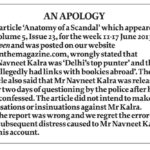Didi, Amma & Behenji
Three women chief ministers, Mayawati, Mamata and Jayalalithaa, are not only in control of the political destiny of over 360 million people, they are also shaping the future of Indian politics
 Hartosh Singh Bal
Hartosh Singh Bal
 Hartosh Singh Bal
|
12 Jan, 2012
Hartosh Singh Bal
|
12 Jan, 2012
/wp-content/uploads/2015/11/matriarchs2.jpg)
The three women chief ministers are not only in control of the political destiny of over 360 million people, they are also shaping the future of Indian politics
When Kanshi Ram first visited Mayawati’s home, her biographer Ajoy Bose writes, she ‘announced somewhat piously, ‘I am studying to pass the IAS exams and become a collector so that I can serve my community properly’.’ Kanshi Ram’s prophetic reply summed up the essence of power in India: “I can make you such a big leader one day that not one, but a whole row of collectors will line up with files in front of you, waiting for orders.” Collectors cowering in Mayawati’s presence are a fact of life in Uttar Pradesh today.
She is not the only one to have realised Kanshi Ram’s prediction. MG Ramachandran could have, perhaps even more theatrically, made the same promise to his protégé and love, Jayalalithaa. When I was reporting on a story on Jayalalithaa in 2005, I was told by an industrialist that as Tamil Nadu Chief Minister, “She sits behind a bare table, several top bureaucrats of the state are seated in a row to her left. As the visitor enters the room, she rises to greet him; so do the bureaucrats, but their eyes are turned towards Jayalalithaa. When everyone is seated, she focuses on the business at hand. She turns to the bureaucrat concerned, who gets up and stands silently, hands folded. She interprets his silence to the visitor, letting him know if a particular demand can be conceded or not.”
Mamata Banerjee, meanwhile, has only begun work on ensuring that a bureaucracy long used to other ways of working falls in line. A senior bureaucrat in West Bengal was recently quoted in the media as saying, “As Chief Minister [of the state], she can always express her displeasure [of] any officer in a private meeting with the officer concerned. But the kind of dressing down senior officers are receiving in the presence of junior officers is insulting and demoralising.”
Mamata Banerjee’s aim, presumably, is to replicate what she achieved at the Centre in the Union Railway Ministry, where even junior officers reporting to her office would take their orders directly from her. Even a matter as trivial as a day’s leave for any of them had to be sanctioned by her, often through a text message.
The result in each case is the same: authority is centralised in the charismatic figure of a chief minister who embodies her party.
THE QUESTION OF GENDER
Politically, between them, Mayawati, Mamata Banerjee and Jayalalithaa control the destiny of 360 million people, roughly 30 per cent of the Indian population. They answer to no one, they seem to trust no one, and they do not subscribe to the politics of dynasty (after all, they are single without any heirs in sight), or for that matter the politics of ideology as usually understood in Indian politics (each has supported both the Congress and BJP at the Centre). They also happen to be women in power in a country where this is uncommon.
Since Independence, India has had 14 women chief ministers: five of the Congress, three of the BJP, Janaki Ramachandran (MGR’s wife who was CM for a month), Rabri Devi (Lalu Prasad’s’s wife), Shashikala Kakodkar (the second CM of Goa after her father Dayanand Bandodkar), and of course Mayawati, Jayalalithaa and Mamata.
In this long list, it is only the last three who have achieved power without belonging to a national party or on the dint of kinship through marriage or birth.
It has been argued that Mayawati and Jayalalithaa were mentored by Kanshi Ram and MG Ramachandran, respectively, and, like all women who enter the arena of politics, needed male patronage to succeed. True as this may be, it leaves out one essential fact. Neither Mayawati nor Jayalalithaa attained her power because she was related to any mentor. The nature of either relationship may have been physical; however, as Ajoy Bose’s book relates, Kanshi Ram sought out Mayawati not because of any such attraction, but because he saw a certain potential that he backed even when his own compatriots and family opposed her. In Jayalalithaa’s case, MGR chose her to enter politics a decade after he met her, over objections by his own family and party. She eventually had to best his wife Janaki politically to succeed in this new role. Both Kanshi Ram and MGR detected political potential in the women. None of this can be said about the women who first inherited power purely through birth or marriage, such as Rabri Devi or even Sonia Gandhi. Perhaps Indira Gandhi falls somewhere inbetween, encouraged to join politics by her father Jawaharlal Nehru but not selected to succeed him. And, in a sense, of the women politicians from the Congress and BJP, Indira Gandhi and Uma Bharati in their attitude and politics are the closest to these three women.
MATRIARCHAL AUTHORITY
In an insightful essay, Madhu Kishwar asked the question, ‘How do we account for the extraordinary clout these women, who came to power in such different ways, have acquired within their parties, the awe they inspire among fellow politicians, and the enormous hold they have over the popular imagination?’ Her answer is worth reproducing in some detail: ‘One common characteristic that Jayalalithaa, Mamata, Mayawati, and to a much lesser extent Sonia Gandhi, share with each other is that they act as though no one could get away with trying to intimidate them…The mesmeric power these women exercise over our political life provides us with interesting insights into the Indian male psyche. While Indian men have made it fairly difficult for ordinary women to feel comfortable as equal participants in the political domain, they tend to succumb easily to the demands of women who have the shrewdness and determination to grasp some dynastic or other leverage that provides them with the crucial opportunity to demonstrate that they are stronger and more resilient than the entire range of men in our politics …’
Further, Kishwar writes: ‘This is a variation of our family scene wherein many men find it hard to deal with wives desiring equality. But the very same man has no difficulty in accepting his mother as an authority figure … or even a wife who begins to assume matriarchal authority. Most women, trapped in dependency, don’t often get to be taken seriously. However, when they manoeuvre themselves into a superior position, whether as mothers, elder sisters, grandmothers, aunts or even well established wives, they acquire numerous advantages that accumulate, including certain well defined rights to order and command.’
Consider the terms used for the three chief ministers: ‘Amma’, ‘Behenji’ and ‘Didi’. These confirm Kishwar’s arguments. These CMs are seen as matriarchal figures, a mother or an elder sister, as the case may be. Such a role almost demands that their sexuality be toned down. This has always been the case with Mamata, with her plain cotton saris, and to a great extent with Mayawati. In Jayalalithaa’s case, sociologist MSS Pandian once told me that it is interesting to note that while she inherited MGR’s legacy, which was built around his image of a larger-than-life film star, the way she projected herself was very different: “You can see it in the way she has completely disassociated herself from her cinematic past. Her cape, the term ‘Amma’, all this seeks to de-sexualise her, distance her from her cinematic image. There was a lesson on Jayalalithaa in [Tamil Nadu] school texts, it contained no references to her association with cinema.”
THE CULT OF THE GODDESS
Kishwar goes on to argue, ‘As pointed out very elegantly by AK Ramanujan, in India we have two kinds of goddesses—the benign consort goddesses like Parvati and Lakshmi… People revere but do not fear them. By contrast, there are far more numerous non-consort goddesses who are far more powerful… As with all the ferocious goddesses of Indian mythology and village lore, Jayalalithaa justifies her authoritarian ways and her vindictive politics as the legitimate response of a woman long wronged and exploited by men, till she rose in fury and decided to give tit for tat, and gave ten kicks for every one she received.’
In 1984, after MGR’s death, his body was placed on a gun carriage for the funeral procession. Millions of viewers watched on TV as Jayalalithaa was pulled away from the carriage by Janaki’s relatives.
‘Mamata,’ continues Kishwar, ‘has built her political career more in the tradition of an avenging deity than a politician. She presents herself as a victim of the CPM’s dictatorship who will not rest till she has destroyed their power. Mayawati does not use any personal history of persecution but claims to be avenging the collective, historic insults heaped upon the entire Dalit community.’ This is certainly true insofar as her identity as a Dalit is concerned, but she does often invoke the Samajwadi Party’s assault on her in a guesthouse in Lucknow when it was clear that the BSP had brought down the coalition government with the SP in 1995.
This cult is carefully nurtured and reinforced by each of them. In Mayawati’s case, the monuments built during her rule speak for themselves. She is the presiding female deity in the temples built to celebrate a religion that commences with Ambedkar, is taken forward by Kanshi Ram, and culminates in her success.
Explaining Jayalalithaa, V Geetha, editor of Chennai-based Tara Publishing, had once told me, “During her first phase in power, she tried to create a cultic image. There was an active identification with religious symbols through the huge cutouts on every street corner — Jayalalithaa astride a lion, Jayalalithaa as Mother Mary.” A signboard even dared to proclaim, ‘Henceforth History will be Her Story.’ Soon enough, MGR, much like Kanshi Ram in Mayawati’s case, was a figure relegated to the background.
In Mamata’s case, it suffices to quote a news item: ‘There were long queues of people at West Bengal Chief Minister Mamata Banerjee’s house here Thursday as she gave away Kali puja ‘prasad’, greeting VIPs and commoners alike…. Banerjee has been organising the puja at her Kalighat residence in south Kolkata since 1978, when she was a student leader. This year, the event was special… The doors of her spartan residence on Harish Chatterjee Street were thrown open to the public. Thanks to her instructions, the security was never obtrusive. Thousands of her supporters visited the single storey house throughout the day to watch the puja on the courtyard and for a glimpse of the popular politician widely known as ‘Didi’. “This is the 34th year of Kali worship in our house. It was her [Mamata Banerjee’s] idea. The rituals are conducted by strictly following the scriptures,” said a member of the household.’
In a state where the Cult of the Goddess is all important, it is not difficult for people to make the association.
THE POLITICS OF PERSONALITY
Such a cult does not allow for friends or equals. Authority such as this has to go unquestioned. To find oneself in such a role is to be beset by a deep insecurity. There is no one you can completely trust. This is not peculiar to Mayawati, Jayalalithaa or Mamata. Regional parties built around a cult of personality tend to force the same insecurity on every politician, be it Mulayam Singh or MK Karunanidhi. But as women who have had to renounce their sexuality, they do not have families to turn to, whereas Mulayam has his son, and Karunanidhi has an entire clan.
This insecurity has defined the politics of these three leaders. Mayawati has, from the time she achieved power, worked to get rid of Dalit leaders who trace their roots in the BSP back to Kanshi Ram, or show signs of establishing a presence of their own. At a time when the party was showing significant progress in Madhya Pradesh, she threw out Phool Singh Baraiyya, the one leader who had worked to ensure this. In Punjab, another state where the BSP was a significant force, old associates of Kanshi Ram like Satnam Singh Kainth have left the party.
The only people Mayawati has trusted, and even this trust is not permanent, are those who can be no threat—such as Pawan Sagar, who went from being her travel agent to her officer-on-special-duty, his wife Poonam, a beauty parlour owner responsible for her makeover, who became a confidante, her one-time telephone operator BS Khushwaha, who represented Other Backward Castes in the party and has now suffered the ignominy of expulsion. The lawyer SC Mishra, who was advocate general of UP during her last tenure and has wooed many of the state’s Brahmins to her side, and Naseemuddin Siddiqui are perhaps the only people in her inner circle with minds and opinions of their own, but then a Brahmin or Muslim can never pose a real threat to her within a party that depends heavily on Dalit votes.
Much the same is true of Jayalalithaa. RR Gopal, editor of Tamil weekly Nakheeran, who has always been at loggerheads with her, had once pointed out, “She has never retained any acquaintance of hers except for Sasikala. After MGR’s death, when one group of the party wanted to eliminate her politically, she absconded to Bangalore for three months. Several prominent AIADMK leaders went there to persuade her to change her mind. Today, not one of them is in favour.” Today, even Sasikala is out of favour, at least for the moment.
It is a pattern Mamata has replicated. She may seek others’ advice, but in the end every decision is her own, often catching even her close advisors by surprise. In the recent Parliamentary vote on the Lokpal Bill, her party MPs had voted with the Government in the Lok Sabha. They were only following a line she had laid down. The vote took place late at night, and they did not consult her immediately before. The next day, they were reprimanded for failing to do so, and Mamata had changed her stand without even the next seniormost member of her party knowing why.
This overt control extends to someone such as Dinesh Trivedi, her handpicked successor at the Railway Ministry, who does not take any major decision without her approval. When he suggested that fares be rationalised by rounding them off to the nearest multiple of ten, it was not the PM or Union Cabinet, but Mamata who vetoed the idea.
THE REALITY OF POLITICS
The question of where their political ambitions will take them next is crucial to the future of Indian politics. And it would not come as a surprise to anyone that each sees herself as a potential Prime Minister.
Writing of the 2009 polls, Ajoy Bose had stated, ‘Mayawati’s chances of becoming Prime Minister depend on how the political melting pot … gets stirred…. A supreme opportunist who has always managed to exploit other people’s compulsions and vulnerabilities to her advantage, the BSP leader is capable of doing business with both the Congress and BJP.’
This remains as true today, and it applies in equal measure to Mamata and Jayalalithaa as well. The Uttar Pradesh polls are crucial. If Mayawati’s BSP emerges as the single largest party and can form a government in Lucknow without the Congress, then we would see a scenario in which general elections are likely sooner than later. Both Jayalalithaa and Mamata have just come off strong Assembly victories, and each sees far greater chances of gathering the same voteshare if Lok Sabha polls are held before their 2014 schedule.
Notably, neither of them has any compunctions doing business with the Congress or BJP. In fact, in their home states, each has only gained at the expense of either of the two national parties.
At the national level, their presence in any alliance with the BJP does ensure one thing, a moderation of extreme Hindutva, since they are dependent on at least a portion of Muslim votes in their own states. But beyond this, they see their involvement with regular national-level politics purely in terms of the advantages they obtain from the Central Government.
If and when the hypothetical situation does crop up, the question is who will be the most likely contender. Mamata’s aim had always been to eject Communists from power. She has achieved that in West Bengal, and she already seems to be floundering. This is a problem she will soon realise she needs to address: who does she speak for and what does she stand for? She only has to look at the other contenders. Jayalalithaa only represents herself; the ideological impetus that formed the basis for the Dravidian assertion in Tamil Nadu had been subsumed under the cult of personality even before she joined politics. This leaves Mayawati. Of the three, she is the only one who stands for something larger than herself. Just by being in power, she confers Dalits in India with something significant, the confidence to deal with local authorities on equal terms in day-to-day transactions. That already is a lot more than can be said about most Prime Ministers this country has had.

/wp-content/uploads/2025/08/Cover_Game-changer.jpg)











More Columns
An India-China Complete Re-set? Desirable but Unlikely Krishnan Srinivasan
Kani Kusruti: Locarno Calling Kaveree Bamzai
Return to Radio Kashmir Kaveree Bamzai